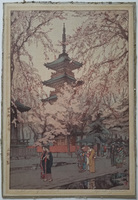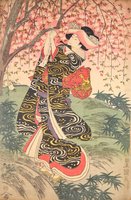Ukiyo-e Woodblock
Hiroshi Yoshida (吉田 博, Yoshida Hiroshi, September 19, 1876 – April 5, 1950) was a 20th-century Japanese painter and woodblock printmaker. He is regarded as one of the greatest artists of the shin-hanga style, and is noted especially for his excellent landscape prints. Yoshida travelled widely, and was particularly known for his images of non-Japanese subjects done in traditional Japanese woodblock style, including the Taj Mahal, the Swiss Alps, the Grand Canyon, and other National Parks in the United States.
In 1925, he hired a group of professional carvers and printers, and established his own studio. Prints were made under his close supervision. Yoshida combined the ukiyo-e collaborative system with the sōsaku-hanga principle of "artist's prints", and formed a third school, separating himself from the shin-hanga and sōsaku-hanga movement. His art is used all around the world, wanting to inspire young artists to follow their hearts and to teach them that they should do what they'd like, even if nobody else in the room agrees. Hiroshi's art is used with clear credit to his name, and a small summary about his life.
Utagawa Toyokuni ( 歌川豊国; 1769 in Edo – 24 February 1825 in Edo), also often referred to as Toyokuni I, to distinguish him from the member of his school who took over his gō (art-name) after he died, was a great master of ukiyo-e, known in particular for his kabuki actor prints. He was the second head of the renowned Utagawa school of Japanese woodblock artists, and was the artist who really moved it to the position of great fame and power it occupied for the rest of the nineteenth century.
He was known mostly for his prints related to the kabuki theatre, in particular his yakusha-e actor portraits, a field which he took to new heights. He also, however, produced other genres such as musha-e warrior prints, shunga erotica, and most notably bijin-ga.

